SECTION A
Questions 1 to 40 carry one mark each.
1. Name one body organ in man that makes use of light energy from the sun.
2. Name one cold-blooded vertebrate that has a body shell.
3. Mention any one way in which a biological change is similar to a chemical change.
4. How can a passion fruit plant benefit from growing near a mango tree?
5. Write down the vector that spreads elephantiasis.
6. To which group of animals does the one shown in the diagram below belong?
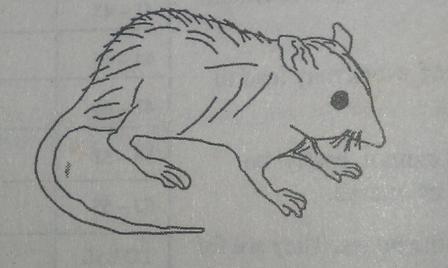
7. Give any one use of wearing sun glasses.
8. Why is a maize grain grouped under monocotyledonous seeds?
9. What is the importance of a web to a spider?
10. How does fish help in conditioning the spread of malaria?
11. Mention any one way in which communicable diseases are spread.
12. Whenever Peter opens or closes his door, the hinges make noise. What can he do to stop the noise when he is opening?
13. Name one structure in a human body which connects bone to bone.
14. Give any one way in which petrol in a car is similar to food in a human body.
15. How are ferns, mosses and liverworts similar?
16. Why should you chew food before swallowing it?
17. How is a chameleon important to human beings?
18. Suggest any one use of a tourniquet.
19. State any one way in which soil is important to insects.
20. What system is responsible for the removal of waste materials from your bodies?
21. What system is responsible for the removal of waste materials from our bodies?
22. State any one result of two naked wires carrying electric current getting in touch with one another.
23. Give the function of the epiglottis in the respiratory system.
24. Write down the type of ventilation shown by the diagram below.
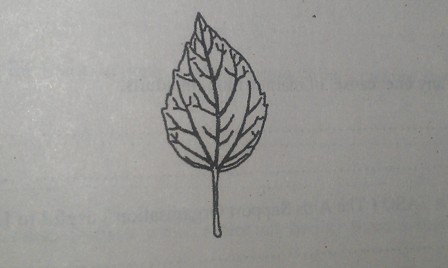
25. State the organisms that can be controlled by use of antibodies.
26. Write down any one piece of advice you can give to a friend in order to promote their personal hygiene.
27. Why s a microscope important to doctors?
28. How does boiling of water help in the control typhoid?
29. State the function of the amniotic fluid during pregnancy.
30. Which type of electricity is produced by generators?
31. Give any one cause of malnutrition in adults.
32. How is TASO (The AIDS Support Organisation) useful to HIV/AIDS victims?
33. What process makes dew to disappear during hot days?
34. Give any one use of reptiles to man.
35. How are green plants important in the water cycle?
36. Mention any one natural resource found under the ground and is used as fuel.
37. Apart from getting medical treatment, write any other piece of advice you can give to a friend suffering from flu.
38. Name the state of matter in which sound travels fastest.
39. Why is it easier for Otim to push a wheel barrow full of manure downhill than uphill?
40. State an immunisable disease which enters our bodies through cuts and wounds.
SECTION B
Question 41 to 55 carry four marks each.
41. Use the diagram below to answer questions that follow.
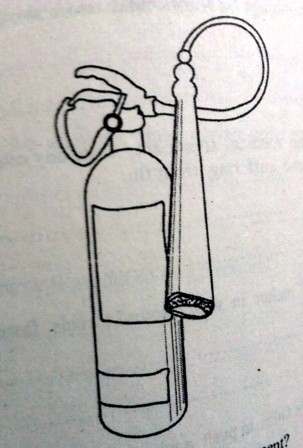
a) What name is given to the above equipment?
b) Why the above equipment is always painted with bright colours?
c) Why is such equipment recommended to be in schools?
d) What gas is contained in the above equipment?
42. a) Apart from the skin, give any one example of a respiratory organ.
b) List any two diseases which affect the respiratory organ in humans.
c) Give any one practice by humans which may lead to a respiratory disease.
43. a) Suggest two reasons why young farmers' clubs are important in schools.
b) Give any two activities that can be done by young farmers' clubs in schools.
44. a) Name any two of the 5Rs in waste management.
b) Suggest any two effects of poor waste management in the environment.
45. The diagram below is of an amoeba. Use it to answer questions that follow.
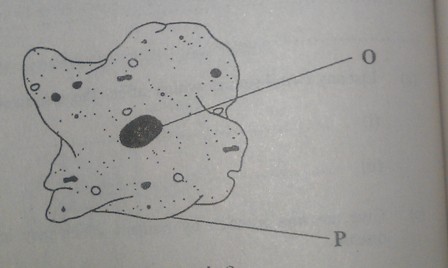
a) What kind of organism is an amoeba?
b) Name the structure indicated by letters O and P
c) How is the amoeba able to move from place to place?
46. The illustration below show different types of light rays. Use them to answer the questions that follow.

a) Name the following rays of light Q and S.
b) Suggest the type of lens that can be used to make light rays move as shown in S above.
c) What eye defect is corrected by a lens which makes rays move as shown in R?
47. A poultry farmer has his chicken passing out blood-stained droppings and have dropping wings.
a) What diseases are likely to have attacked the farmer's birds?
b) Suggest two ways in which the neighbours to the farmer can prevent their birds from contracting the above disease.
c) Why should the farmer separate the birds with the above given conditions from the rest?
48. The diagram below is of a chain. Study it and answer the questions that follow.

a) Name the producer.
b) Which living organism in the diagram is herbivorous?
c) Why is the organism in (b) above herbivorous?
d) Name one way in which plants benefit from the goats.
49. The diagram below is of a pulley system. Use it to answer questions that follow.
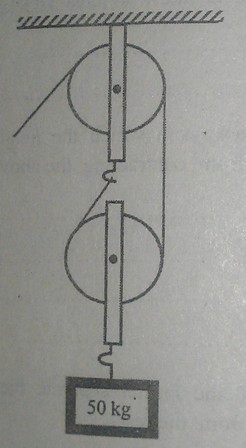
a) Name the type of pulley system shown above.
b) Use an arrow to show the direction of effort.
c) If the mechanical advantage of the machine is 2 and the load being carried by the machine 50kg, find the effort needed to raise that load.
50. a) Give two reasons for placing utensils on a rack.
b) Why should a rack be constructed with stands at least 1 meter above the ground?
c) Suggest one danger of leaving utensils for a long time outside on a rack.
51. a) Mention any one method of harvesting root crops.
b) Give any three ways in which weeding helps on the proper growth of root crops.
52. a) What name is given to the liquid part of blood?
b) Name one component of the liquid part of blood.
c) Give two uses of the liquid part of blood.
53. Give the meaning of the following words as used in cattle-rearing.
a) Insemination
b) Cross-breeding
c) Castration
d) On heat.
54. a) What is meant by the term silting?
b) Apart from killing fish, how else does silting affect fish?
c) List any two major causes of silting.
55. The diagram below shows a life cycle of an insect. Use it to answer the questions that follow.
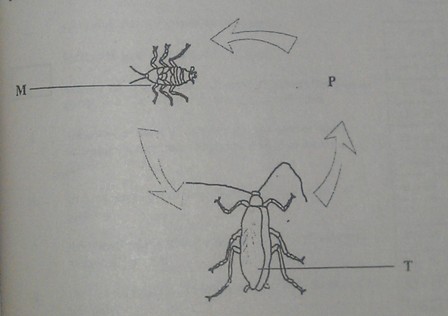
a) Name stages marked M and T.
b) Name one insect that undergoes the above stages of development.
c) Draw the stage marked with letter P.
